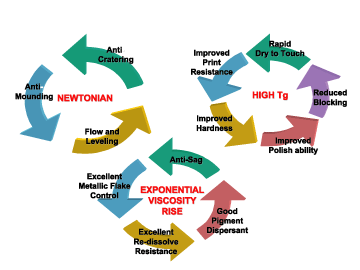
Cellulose ester technology has been used in coatings since 1890 when cellulose nitrate (NC) was found to be useful as a coatings resin. Cellulose acetate (CA) and mixed cellulose esters such as cellulose acetate butyrate (CAB) and cellulose acetate propionate (CAP) were developed in the 1930s as a less flammable alternative to nitrate-based coatings for military aircraft. Cellulose esters can be used as binder resins or as additives to coatings to provide application properties and resist film defects.

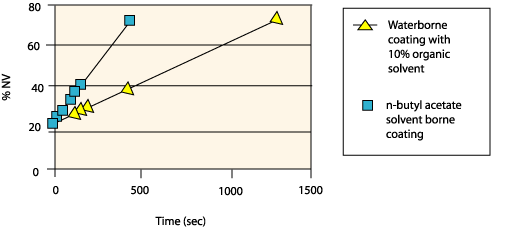
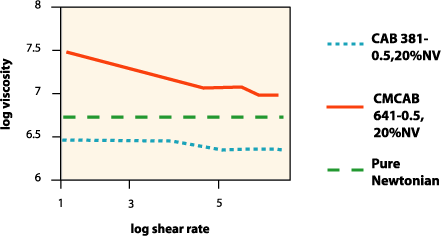
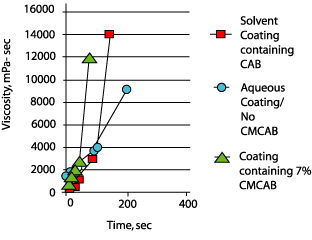
In waterborne coatings systems, the percent solids increases more slowly due to the slow evaporation rate of water (see Figure 3), especially at higher humidity. This slow evaporation makes it difficult to prevent a waterborne paint from dripping or sagging if it exhibits good flow and leveling. Avoiding these properties requires careful adjustments of the rheological profile of the coating. Rheology-control agents such as alkali-swellable thickeners, associative thickeners and clays are used to build viscosity rapidly to prevent the coating from dripping off vertical substrates. By using these agents, the viscosity increases rapidly due to a decrease in shear rate instead of relying on a rapid increase in solids and viscosity due to evaporation. Rheological additives that prevent dripping also aid in keeping the pigments dispersed. However, the elasticity introduced by such additives can be detrimental to flow and leveling and can propagate other film defects. To compensate for some of these problems, other additives are then needed to reduce the surface tension of the fluid in order to facilitate flow and leveling.2-3 The balancing act between good flow and leveling and sag control can be difficult to achieve.
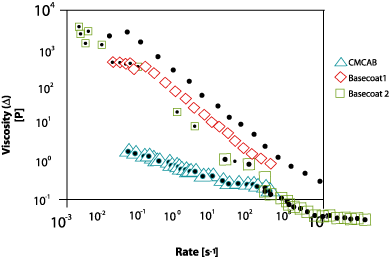
To use CMCAB cellulose ester in a waterborne coating formulation, it must first be dissolved in a suitable solvent system such as ethylene glycol butyl ether. In order to make an aqueous dispersion, this solution then needs to be partially neutralized with a suitable base such as an organic amine, diluted with water to form a dispersion, and then further neutralized with base to achieve the desired pH. The CMCAB solution or dispersion can then be added to the coating.
The acid number of the CMCAB cellulose ester is 60; to obtain a stable aqueous dispersion, only some of the acid functionality should be neutralized. Complete neutralization of the acid on the CMCAB may result in partial hydrolysis of the ester, leading to viscosity changes and precipitation. The method outlined is based on an ethylene glycol monobutylether solution and results in a 15% neutralization of the acid functionality on the CMCAB. Other solvents may be used to dissolve the CMCAB cellulose ester ranging from ketones, esters, and various glycol ethers as appropriate.
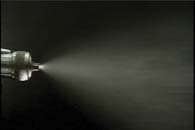
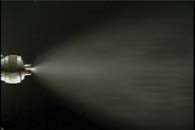
Experimental Materials
CMCAB cellulose ester dispersions were prepared by dissolving 20 g CMCAB 641-0.5 into 30 g ethylene glycol monobutylether on a high-shear mixer. Fifty g of water containing 0.5% dimethyl ethanolamine was added slowly with rapid mixing.Waterborne basecoats were prepared by dispersing Silberline E3053 Aluminum pigment paste in an acrylic dispersion (Eastman Jagotex EM325) and adding CMCAB dispersion or Borchigel 75N polyurethane thickener (Borchers) to achieve a P/B of 0.15. Basecoat pH was adjusted to 8.5 and basecoat viscosity was adjusted to 15.5 sec DIN 4.
Commercial waterborne basecoats were obtained from the manufacturers.
Waterborne clears were prepared by mixing Paraloid WR97 (Rohm and Haas) and Cymel 327 (Cytec) at a solids ratio of 50/27. The pH was adjusted to 8.5 with AMP-95 (Angus) and BYK 380 was added at 0.15%. This was further modified with either 10% CMCAB on solids or 3% ASE-60 (Rohm and Haas) on solids.

Measurement Techniques
The viscosity curves in Figure 4 were obtained using a Haake RV-20 viscometer equipped with a Couette fixture. To retrieve data at lower shear rates, shown in Figure 5, another rheometer was used. The steady shear viscosity and dynamic viscosity were measured on a Rheometrics Dynamic Stress Rheometer (DSR) at 25 deg C. The steady shear viscosity was measured using a Couette fixture of 32 mm diameter cup and 29.5 mm diameter bob with 44 mm length. The zero shear viscosity was estimated from the Newtonian plateau at the shear rates around 10-3 sec-1 or lower. The dynamic frequency data were measured using 40 mm diameter parallel plates with 0.5-1 mm gap under a 10 dyne/cm2 stress set.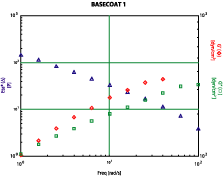
Results
Figure 4 shows the near-Newtonian nature of a CMCAB cellulose ester water dispersion compared to a solventborne CAB system and pure Newtonian rheology. The rheology change of the coating material upon application to the surface is of great interest. Figure 5 demonstrates that the increase in viscosity of a CMCAB-based water dispersion during spray application is faster than that of a waterborne system without CMCAB cellulose ester. It should be noted that the faster viscosity increase of the CMCAB system is not due to faster solvent evaporation but due to faster increase in viscosity and elasticity during drying. Figure 6 compares the viscosity vs. shear rate behavior of a waterborne basecoat containing CMCAB cellulose ester to the behavior of two commercial waterborne basecoats. The CMCAB basecoat exhibits near-Newtonian behavior.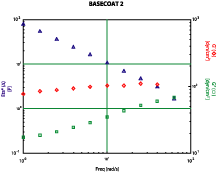

Figure 9 shows the dynamic mechanical behavior of a CMCAB cellulose ester system in comparison with two commercial basecoats. The basecoat containing CMCAB shows very different viscosity and elasticity behavior than the two commercial basecoats.2-3 In particular, the elasticity (G') of the CMCAB system is very much lower than the other two basecoats.
Conclusion
CMCAB cellulose ester appears to exhibit unique rheological properties in waterborne coatings. Comparisons of rheology behavior and elasticity measurements of a waterborne coating containing CMCAB cellulose esters to waterborne coatings using other rheology control agents indicate that CMCAB provides a different rheology control mechanism. Spray patterns and flow of coatings material immediately on application also support a unique rheology control mechanism. Thickening behavior as a function of solids increase and near Newtonian behavior in the film supports observations of good flow and leveling combined with sag resistance.This article is based on a paper presented at the 30th International Waterborne, High-Solids, and Powder Coatings Symposium February 26-28, 2003, in New Orleans. Symposium sponsored by The University of Southern Mississippi School of Polymers and High Performance Materials.
For more information, contact Jonathan E. Lawniczak, Eastman Chemical Company, P.O. Box 431, Kingsport, TN 37662.
References
1Posey-Dowty, J.D.; Seo, K.S.; Walker, K.R.; Wilson, A.K. (2002) "Carboxymethylcellulose Acetate Butyrate in Water-based Automotive Paints," Surface Coatings International, Vol 50, 303-08.2 Osterhold, M. (2000) "Rheological Behavior of Automotive Paint Systems: Modern Characterization Methods with Good Correlations to Observable Effects." European Coatings J., Vol. 4/00 18-33.
3 Boggs, L.J.; Law, D.; Taniguchi, H. (1998) "Rheological Properties and Aluminum Flake Orientation in Waterborne Automotive Coatings," International Waterborne, High-Solids. And Powder Symposium: New Orleans, February 18-20, 1998.


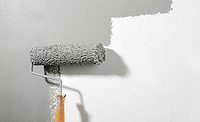
Report Abusive Comment